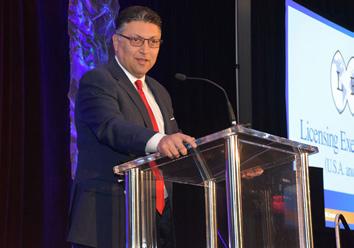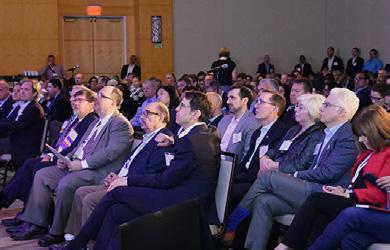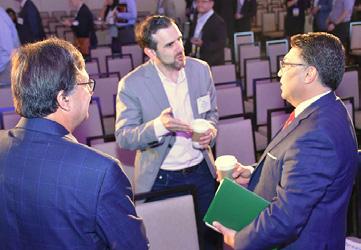
4 minute read
Evolution Of Innovation, IP Licensing, And Antitrust Law
By Meredith Holmes
One of the highlights of the 2019 LES Annual Meeting was the address by keynote speaker, Makan Delrahim, Assistant Attorney General at the U.S. Antitrust Division, Department of Justice. In his talk, “The Times They Are a’Changin’: the Nine No-No’s in 2019,” Delrahim discussed the latest developments in legal thinking about innovation and regulation.
Advertisement
The “Nine No-No’s” refers to a list of patent licensing clauses developed in the 1970s by Bruce Wilson, then-Deputy Attorney General at the Department of Justice. These practices were considered per se illegal, but as technological innovation burgeoned, regulation relaxed, and most of these practices are no longer automatically prohibited. Makan Delrahim discussed the shifting landscape of licensing and antitrust law.
Charles Macedo, partner at Amster, Rothstein & Ebenstein, LLP, the New York intellectual property law firm that sponsored Delrahim’s speech, took the podium to outline the speaker’s career. Delrahim was confirmed on September 27, 2017. His antitrust experience is broad, covering a full range of industries, issues, and institutions. He served as Deputy Assistant to the President and Deputy White House counsel. He was a partner in the Los Angeles office of a national law firm, and served the antitrust division from 2003 to 2005 as a Deputy Assistant Attorney general. From 2004 to 2007, he was a Commissioner on the Antitrust Modernization Commission.
Ron Laurie, with LES and InventionShare, introduced Delrahim, noting that he is the first patent attorney to head up the Antitrust Division, and that his attempts to “harmonize” the patent law/antitrust law interface are a “breath of fresh air.”
Delrahim began by quoting from Chief Justice Sandra Day O’Connor’s memoir about growing up on a cattle ranch. She remembered her parents clinching a sale with just a handshake, but years later, requiring a written contract and a down payment. This is a perfect example, Delrahim said, of how IP law and antitrust law have shifted in response to changes in technology, culture, and policy.
He focused on five licensing practices, saying, “These particular socalled No-No’s shed light not only on how antitrust thinking has evolved over the last two decades, but also reveal that more work can be done to secure healthy, dynamic competition.” He discussed:
• A licensor’s restrictions on a licensee’s freedom to deal in products or services outside the scope of the patent;
• Payment of royalties beyond the scope of the patent;
• Resale price maintenance;
• Tying;
• Mandatory package licensing.
The scope of the patent
The justification for restricting the licensee’s ability to deal in products outside the scope of the patent, Delrahim said, is similar to the argument used when a standard-setting organization wants to use a patented technology to achieve interoperability. Some are concerned that this practice unduly increases the market power of the patent holder, but Delrahim asserted that these concerns are “overstated.” He is guided by his “New Madison” approach to antitrust law, which seeks to ensure patent holders have incentives to innovate, but refrains from intervening to limit the market power of any enterprise.
Minimum and maximum; vertical and horizontal
Tackling the No-No regarding resale price maintenance (RPM), Delrahim pointed out that in 1968, the U.S. Supreme Court ruled that maximum vertical price fixing was per se illegal. But 30 years later, the Court overturned that decision, saying that such arrangements should be evaluated under the rule of reason. Similarly, minimum RPM, which since 1911 had been considered per se illegal, was overturned in 2007. This decision is so recent, Delrahim said, that its effects on IP licensing are unknown. He concluded, “…the Division will apply a rule of reason analysis, weighing the competitive harms and benefits of each situation.”
Tying still tied up
Tying—requiring the purchase of unpatented materials as a condition of a patent license—was considered per se illegal, if the patent owner has some market power over the tying product. Simply owning a patent conferred market power. Although court decisions on tying cases vary, there is some movement toward considering the competitive benefits of the practice. In 2006, the U.S. Supreme Court ruled that in all cases involving tying, “the plaintiff must prove that the defendant has market power in the tying product.” Delrahim discussed the 2001 case involving the tie between the Microsoft Operating System and Microsoft’s Internet Explorer, and how the Antitrust Division has dealt with tying in the rapidly changing movie industry.
Delrahim concluded, “Although many of us continue to hold strong views on precisely how the two regimes—IP and antitrust law—ought to complement each other, I am grateful the conversation is now at least more nuanced than the simple No-No the division gave decades ago.”

Makan Delrahim opens the meeting with his plenary talk.

Makan Delrahim opens the meeting with his plenary talk, while LES leaders listen.

LES leaders listen and discuss points with Makan Delrahim afterwards.









